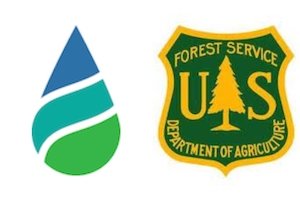Renewed Partnership between Blue Forest and U.S. Forest Service: A Pathway to Resilient Ecosystems


We’re pleased to share that we recently renewed our long-standing partnership with the U.S. Department of Agriculture (U.S. Forest Service) through a new Challenge Cost Share Agreement (CCSA).
Written by: Mariam Jallow
In May 2023, Blue Forest and the U.S. Department of Agriculture (Forest Service) renewed their long-standing partnership with a new Challenge Cost Share Agreement (CCSA). The agreement represents a shared commitment to restore ecosystems and mitigate the risk of catastrophic wildfires across National Forest System lands.
The new CCSA between Blue Forest and the Forest Service is centered on reducing the risk of catastrophic wildfire in high-risk landscapes through the joint development of Forest Resilience Bond (FRB) projects. These projects aim to enhance forest ecosystems and address the pressing issues of wildfires and climate change in priority landscapes. The partnership and work will “promote community engagement, collaborative capacity building, and cost sharing across stakeholders” to accelerate the pace and scale of work to address forest and watershed health.
“This agreement represents the Forest Service commitment to expanding and enhancing its partnership with Blue Forest by directing Inflation Reduction Act funds towards development and implementation of Forest Resilience Bond projects that leverage private investment to reduce wildfire risk, ” said National Forest System Associate Deputy Chief Troy Heithecker. “Our work with Blue Forest demonstrates the huge potential of public-private partnerships to accelerate the pace and scale of forest restoration across the West, and exemplifies the Forest Service’s commitment to innovation in tackling the wildfire crisis,” he added.
The new CCSA builds upon six years of partnership between Blue Forest and the U.S. Forest Service Conservation Finance Program. Their collective efforts have already financed $30 million to accelerate the pace and scale of treatments on 40,000 acres of the Tahoe National Forest and in 2023 expanded these efforts to the Rogue Valley in Oregon.
About the CCSA
The CCSA outlines a framework to support the implementation of the Forest Service’s 10-year plan for confronting the wildfire crisis in the Western United States. This strategy prioritizes safeguarding communities and vital resources through measures such as increased fuel treatments and promoting community readiness. The framework includes scaling the development of public-private partnership models, including FRBs, with the primary objective to rejuvenate ecosystems and mitigate wildfire hazards across National Forest Service lands.
The significance of the new Challenge Cost Share Agreement
The new CCSA is an enhanced level of cooperation between Blue Forest and the U.S. Forest Service. By leveraging private investment through FRB projects, the collaboration enables a more extensive and efficient approach to forest restoration and wildfire risk reduction— leading to a more resilient and protected National Forest System.
“We are excited to deepen our work with the Forest Service, continuing to advance work across California, Oregon, Washington, and Montana, and expand to additional geographies to reduce the risk of catastrophic wildfire, restoring ecological health and protecting communities and municipal watersheds,” said Blue Forest Chief of Staff and Policy Director, Mac Cloyes. “The CCSA will help scale work on specific projects and also build capacity and outcomes analysis that will help build foundation to long-term restoration activities.”
Blue Forest Managing Director of Project Development, Jeannie Davidson highlights that since Fall 2022, Blue Forest has already engaged with “over 25 National Forests across four Forest Service Regions to build capacity and develop over $100 million in potential Forest Resilience Bond projects.”
In the future, Davidson foresees that Blue Forest will “deploy the Forest Resilience Bond to high priority projects that project source water and communities and continue to advance work across the states of the west coast, Montana, and expand to additional geographies” with the help of the Forest Service.
Through this collaboration, solutions are being supported to protect and restore precious ecosystems while mitigating wildfire risks. As we await to see more outcomes of this partnership, we are optimistic to witness the work in creating a more sustainable future for our forests and communities.